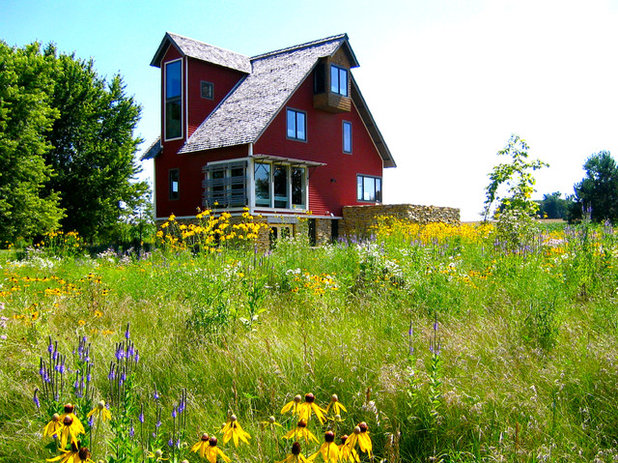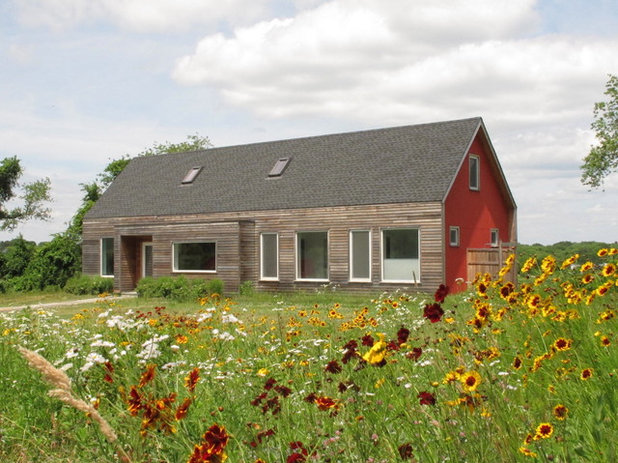Every fall I walk through my small garden and gather seeds from my region’s native perennials. I have a little paper lunch bag for each plant (nearly 100), labeled and dated, that I store the seeds in. Sometimes I take a mix of six to 10 carefully selected plants, put them in one bag, drive down a rural road appropriate for wildflowers and hang the bag out of my car window until it’s empty. I have yet to see anything sprout alongside the road’s edge, but a guy can hope. Do you have a little bit of this in you, too? Ever wondered about making seed bombs?
Before we go any further, you should note that I’m not encouraging you to make seed bombs for the express goal of tossing them into your neighbors’ fields or lawns or city parks or vacant lots — that might be illegal or at least rude (tempting, though). You can use seed bombs in your own garden or as economical plant gifts for whoever you think might benefit.

Locus Architecture
Ready for the recipe? It’s simple: clay powder or soil, compost, seeds and water.

Benjamin Vogt / Monarch Gardens
Find some clay. This is the main ingredient and what binds it all together. I bought a massive block of potter’s clay online, something like 20 or 30 pounds. I couldn’t find powder. Roll chunks of the clay into long strips to dry, which you can do outside in the sun or inside the house. It took me just one day to dry these outside on a windy, warm day.

Benjamin Vogt / Monarch Gardens
Make clay powder. Snap your long strips into small chunks and pound them into a powder with a mortar and pestle (inexpensive and easily found online). You could also find another way to grind up the dried clay, but this is the easiest and least messy. You will need far more clay powder than any other ingredient, so plan accordingly.

Benjamin Vogt / Monarch Gardens
Get compost. I get free compost from my city, and it makes a nice fertilizer for germinating seeds. You might make your own and that’s even better. Sift out any chunks of wood or other debris so you have a nice, powdery soil.

Benjamin Vogt / Monarch Gardens
Choose and clean your seeds. Clean the chaff from your seeds. Any chaff or other bits of organic matter from the plant will make the seed bombs more likely to crack when they’re dry. The same goes for the finely sifted compost. Here I’ve got a mix of sideoats grama grass, wild senna, blue sage and some gray-headed coneflower. I did not do a good job cleaning the seeds, but I like living dangerously.

Benjamin Vogt / Monarch Gardens
Mix it all together. Mix 5 parts clay powder, 1 part compost and 1 part seeds. Slowly add water until it’s a nice sticky consistency but not dripping wet. Take a glob of the mixture and roll it into a ball. Repeat until you get tired.
They’ll take several days to dry — again, faster in the sun and slower indoors. You can certainly cheat a little on this recipe — I’ve done 3 to 4 parts clay so I wouldn’t have to grind up so much powder, and even used a bit more seed. Experiment. Have fun.

Nilsen Landscape Design, LLC
Toss. Place your seed bombs out in a bed that looks a bit sparse. The rain will slowly dissolve the ball, and the seeds will germinate. You can use almost any seed — if you want flowers right away, use an annual seed mix. If you’re placing in the fall or winter, you can use perennial flowers that will need a period of subfreezing, wet weather to germinate before spring. Whatever you do, I strongly encourage using seeds native to your area, which will benefit wildlife and other plant communities more.
So what do you think? Will you try making seed bombs? How will you use them?





